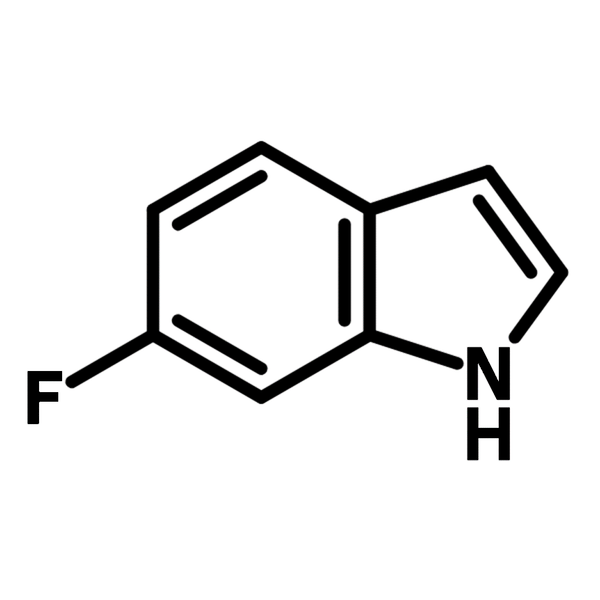6-Fluoroindole
CAS Number 399-51-9
Chemistry Building Blocks, Fluorinated Building Blocks, Heterocyclic Building Blocks, Materials, MonomersA fluorinated indole
Used as a synthesis intermediate for bioactive compounds and polyindoles in application of APIs, fluorine-labelling compounds, OLEDs, semiconductors and DSSCs
Specifications | MSDS | Literature and Reviews
6-Fluoroindole (CAS number 399-51-9) is a fluorinated (6-position) indole, a benzene ring fused pyrrole heterocycle. 6-Fluoroindole is an antimicrobial which works by interfering with the quorum sensing system of the pathogens. 6-Fluoroindole inhibits the biofilm formation that causes infections.
6-Fluoroindole can be easily functionalized with Bpin groups (pinacol boronate) at 2-, 3-, 4-, 5- and 7-positions selectively with iridium-catalysed borylation and bismuth-catalysed protodeboronation. The modification to 6-fluoroindole allows late-stage functionalization on different positions of the molecule, expanding the molecular library for drug discovery.
6-Fluoroindole is also used to label bacteria cells (Escherichia coli) in order to study the protein-protein interaction in vitro with 19F NMR and 15N-1H HSQC (heteronuclear single quantum coherence) NMR.
Multiple functional groups
For facile synthesis
Fluorinated indole building block
For drug discovery, OLEDs, and semiconductors
Worldwide shipping
Quick and reliable shipping
High purity
>98% High purity
General Information
| CAS Number | 399-51-9 |
| Chemical Formula | C8H6FN |
| Full Name | 6-Fluoro-1H-indole |
| Molecular Weight | 135.14 g/mol |
| Synonyms | N/A |
| Classification / Family | Fluorinated building block, Heterocyclic building block, APIs, OLEDs, Semiconductors, DSSCs |
Chemical Structure

Product Details
| Purity | 98% |
| Melting Point | Tm = 72 °C – 76 °C |
| Appearance | Off-white powder |
MSDS Documentation
Literature and Reviews
-
Antibiofilm and antivirulence properties of indoles against Serratia marcescens, S. Sethupathy et al., Front. Microbiol., 11, 584812(2020); DOI: 10.3389/fmicb.2020.584812.
-
Bismuth acetate as a catalyst of the sequential protodeboronation of di- and triborylated indoles, F. Shen et al., Org Lett., 18(7), 1554–1557(2016); DOI: 10.1021/acs.orglett.6b00356.
-
Hexafluoroisopropyl carbamates as selective MAGL and dual MAGL/FAAH inhibitors: biochemical and physiochemical properties, M. Barth et al., ChemMedChem, 17, e202100757(2022); DOI: 10.1002/cmdc.202100757.

 6-Fluoroindole MSDS Sheet
6-Fluoroindole MSDS Sheet